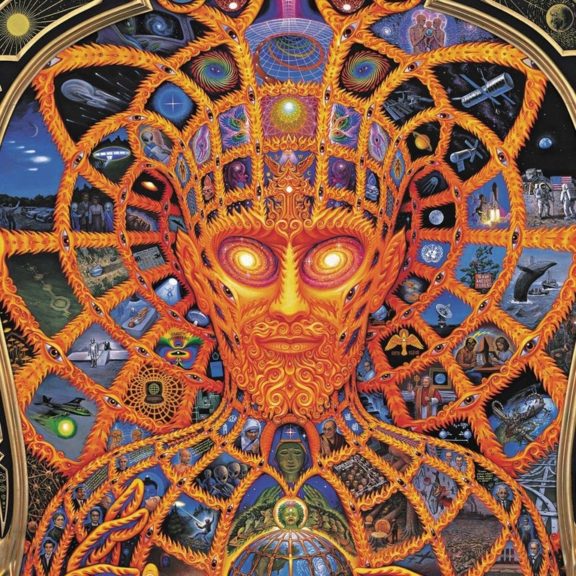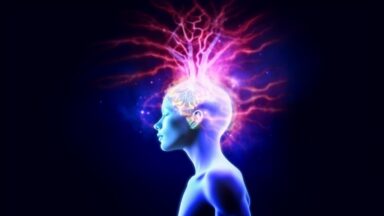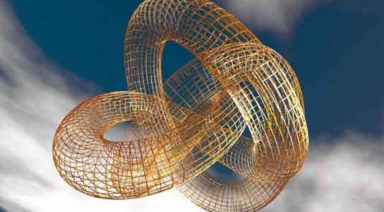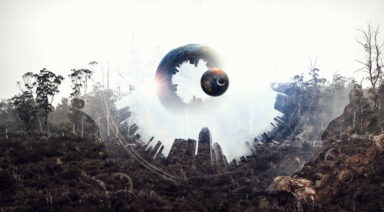Scientists Want to Know More About DMT Entities People Encounter

DMT is one of the most potent entheogens known to man, and the trip it induces is significantly different than other psychoactive substances. Users describe being transported to a distant realm where they meet seemingly autonomous entities, and often those same entities appear to different people. Now, researchers are attempting to catalog these experiences to figure out just what, or who, those DMT entities are.
DMT comes in more than one form and is an endogenous compound found in a multitude of plants, animals, and humans. Since it was synthesized in 1956 by Hungarian chemist Stephen Szara, it has baffled both users and researchers alike.
Recently, Dr. Roland Griffiths, a behavioral psychiatrist at Johns Hopkins University, published a questionnaire asking anyone who has taken DMT and met autonomous entities–beings that seem to act independently of one’s self–to provide details of their experience.
The questionnaire asks about dosage and whether users had a “breakthrough” experience, which is sometimes referred to as “blasting off.” During these higher doses, users feel as if they were transported outside their bodies to another dimension by seeming to breakthrough a membrane of sorts – not unlike being reborn into a psychedelic plane.
In a separate study, Dr. Rick Strassman and Andrew Gallimore have proposed an experiment to keep someone in the DMT realm for an extended period through intravenous administration. The idea was inspired by one of Strassman’s clinical tests involving four psychedelic doses given to subjects, during which themes and a storyline evolved over the course of multiple trips.
These studies hope to uncover some of the similarities between disparate participants’ trips to see if the DMT realm may actually exist outside human consciousness, rather than being a product of it.
Thought leaders in the psychedelic world including Terrence McKenna, Graham Hancock, and Daniel Pinchbeck have provided some interesting insights into their own experiences consuming DMT, Ayahuasca, and similar variants; below are some of their stories.
DMT Aliens and Elves
Terrence McKenna, the eminent psychonaut who devoted his life to exploring the many realms of the psychedelic experience, distilled his 30 to 40 DMT trips down to one general experience when speaking to an audience in 1994.
During this speech, he painted a picture in his audience’s mind that became a common description of specific entities many claim to have met during a DMT session. Though he conceded that words were insufficient to describe them, he referred to them as the machine elves.
McKenna described his experience and the approximate amount of DMT needed to be smoked to achieve the “breakthrough.” From there, he describes hearing an ever increasing, high-pitched noise, similar to the sound of ripping cellophane or a crackling flame, before physically breaking through a membrane and arriving in the DMT reality – a place completely alien from the reality we know.
McKenna names this place the dome, the first archetypal location that he acknowledges DMT “aficionados” will know what he’s referring to. Many people find themselves in this domed, usually subterranean, place characterized by its jeweled, geodesic, and fractalized qualities.
There McKenna describes being met by the so-called machine elves who cheer “hooray” and are clearly enthralled by his presence. He references the Pink Floyd lyrics, “the gnomes have learned a new way to say ‘hooray,’” believing they may be referencing a similar psychedelic experience, that same archetype of the machine gnome.
McKenna says they tell him they’re happy he’s made it and that he doesn’t visit often enough. He describes the elves, not like we might imagine elves, but as squeaking, jeweled, self-dribbling basketballs made of grammar and light.
These DMT entities keep him on task and prevent him from being too awestruck by the wonders he sees. Instead they encourage him to create physical reality through song, like they do.
Acknowledging that roughly five percent of users experience these similar visions and sensations, McKenna had clearly done some research to uncover the learnings that Dr. Griffiths is searching for.

McKenna also described his experiences with DMT as alien, imagining that if aliens exist they might hide in these experiences. He imagines an ethical extraterrestrial entity perceiving humans as “hard-headed, rationalists,” that only open themselves up to mystical experiences by ingesting psychedelic compounds, or as he puts it “getting loaded.”
Though many find the DMT trip to be too bizarre to attach any profundity to, McKenna found it deeply meaningful. He believed it could be a glimpse into reality after death, a parallel spirit realm existing not too far from our own.
This takeaway seems to be more common from DMT’s more spiritual medium; the Ayahusca brew. Graham Hancock, among others, shares that sentiment.
Graham Hancock’s Ayahuasca Entities
Hancock has been a vociferous proponent of the medicinal power of Ayahuasca in shamanic ceremonies. An avid consumer, Hancock says he participates in these rituals multiple times per year, touting the medicine as having cured him of a lifetime of chronic migraines and a cannabis habit he realized had negative impacts on his life.
But when he speaks about his experiences with the DMT-containing Ayahuasca, he says he experiences a recurring entity that is always concerned with his well-being. He refers to this DMT entity as Mother Ayahuasca.
Hancock says he believes every adult has the right to choose to use cannabis and that he believes it has practical uses, but he found his chronic abuse was beginning to wear on his life and his partner. After decades of using cannabis, he was told by Mother Ayahuasca that the plant was no longer serving him. He said she reviewed his life and showed him his death, depicting what would happen if he continued on his path.
Hancock stopped using the plant, explaining that it felt as if a monkey was lifted off his back, leading to a mental clarity that improved nearly every aspect of his life.
But Hancock also points out that there are other entities in the DMT realm that don’t have our best interests in mind. He mentions negative entities that want to hoodwink us, much like an archetypal demon. He says he met many of these entities when he was shown his death, describing them like something out of a Hieronymus Bosh painting.
That Ayahuasca Mother Hancock so endearingly references, often shows itself in the form of animals as well. A snake is a common entity taken by Mother Ayahuasca, and in his book, The Cosmic Serpent, Jeremy Narby asserts that the DNA double helix was shown to humans through the serpentine entities of Ayahuasca.
The serpent has been represented throughout various cultural symbols, such as the caduceus, kundalini life force, the Mayan god Quetzalcoatl, and the serpent in the Garden of Eden.
Jaguars are another DMT entity often experienced through Ayahuasca. In fact, shamans are said to be able to physically turn into a jaguar at will, something attained through becoming one with this entity over the course of many ceremonies.
Daniel Pinchbeck’s DMT Demons
With many psychedelic experiences, users are often confronted with bottled-up emotions, forcing them to deal with issues that may not be pleasant – the death of the ego, as it were. These feelings, buried under layers of emotional scar tissue, can be difficult to deal with and can manifest in the form of ostensibly physical demons.
This can be incredibly frightening during the trip, but users often report a sense of accomplishment or closure for dealing with them after the fact. The term ‘confronting your demons’ can become very literal on psychotropic compounds.
But with DMT, this isn’t always the case. Rather than entities born from individual emotion, people describe meeting entirely autonomous entities, so bizarre and alien that one can’t possibly imagine having created them with their mind. Hence, the reason Dr. Griffiths is so intrigued.
In his book, Breaking Open the Head, Daniel Pinchbeck describes meeting negative autonomous entities that continued to haunt him for weeks after his trip with a DMT molecular variant called DPT.
Similar to some accounts of DMT entities, Pinchbeck said the beings he encountered expressed disdain or pity for his presence as a mere human. Others have said they experienced indifference from DMT entities or messages saying, “Ok, you’ve seen it, now leave.”
But with DPT, Pinchbeck was subjected to a terrifying world of gothic insects, lizards and winged creatures, describing it as a postmodern demonic MTV psychedelic. He realized in retrospect that taking a drug of that magnitude without the shamanic ceremonial aspect was disrespectful and maybe a factor in his frightening experience.
In the weeks following, Pinchbeck had strange synchronicities, bizarre dreams, and what he describes as a poltergeist in his apartment. Mirrors fell off the wall in the night, strange foreign bugs appeared, and unusual physical sensations plagued him. He confirmed the presence of negative energy with others and held an exorcism to rid himself of them.
In the end, a Buddhist meditation helped purge him of the demon, bringing his life back to normal. To Pinchbeck, the entities met on this DMT analogue couldn’t have been more real or more autonomous.
It’s hard to tell whether Dr. Griffiths and his colleagues will be able to uncover just what or who exactly these DMT entities are based solely on stories from strangers on the internet. Dr. Rick Strassman conducted a more in-depth experiment with his work creating the book and documentary, DMT: The Spirit Molecule, though Griffiths comes from a different filed of expertise.
Are these entities really autonomous beings living in a parallel dimension not too far from our own, and will probing deeper give us a better understanding of how they may relate to reality as we know it?
Bicycle Day 2022 – 79 Years Since Albert Hofmann's LSD Discovery

Eight years before Albert Hofmann first synthesized LSD in 1938, Harry J. Anslinger was appointed the founding commissioner of the U.S. Treasury’s Federal Bureau of Narcotics. While both men were of Swiss descent and their life’s work centered around public drug use, their paths couldn’t have been more divergent. And now for this year’s Bicycle Day, as the tides of drug policy are shifting quicker than ever, their stories are increasingly relevant.
While most consider the United States’ war on drugs to have started with the Nixon or Reagan administrations, author Johann Hari in his book Chasing the Scream: The First and Last Days of the War on Drugs, urges our reconsideration of the country’s infamously failed attempt at drug prohibition to an earlier date.
Hari argues that based on racism, classism, and other prejudices, Anslinger was largely responsible for creating a zeitgeist of public misconception about nearly every drug, without regard to therapeutic applications or larger societal implications.
And though Anslinger’s tenure ended just before the criminalization of LSD, it was the foundation he set in place that widely villainized the chemical for decades.
But with the recent relaxation around psychedelic substances and the recognition of their potential as powerful healing modalities, Hofmann’s radical discovery may finally be realized for what he envisioned it could be.





































